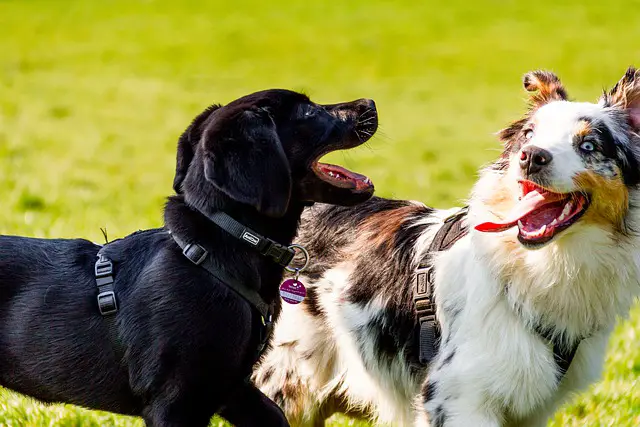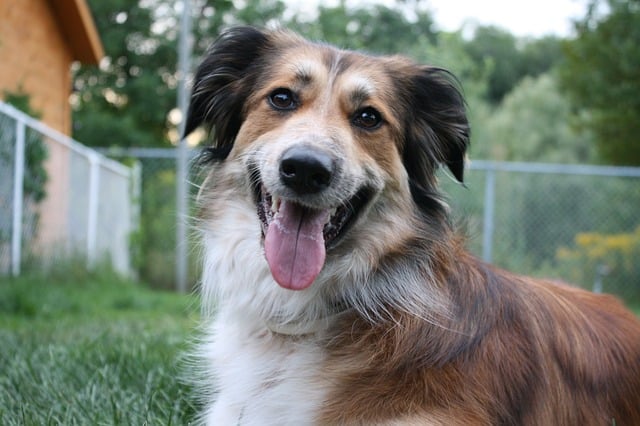The Australian Shepherd is a breed that has been bred and used for herding sheep and cattle. They are, in fact, the cowboy’s choice for a herding partner and can be found on many a ranch. They are just as hard-working as the cowboys!
The Australian shepherd is not really Australian at all. Their ancestors were Pyrenean shepherds, also herding dogs, raised by the Basques, an indigenous people of Europe, who traveled with these dogs to Australia and later to California.
It was there, in California that the Australian shepherd was perfected, also adding collies and border collies to the mix. So, essentially, Australian shepherds were made in the USA!
Along with being the friend and co-worker to cowboys, the Aussie can be found in rodeos, either as a performer of tricks or herding bulls.
Today, Aussies are often found as search and rescue dogs, drug sniffers for law enforcement, service dogs for the disabled, or therapy dogs. As you can see, these dogs seem to live to work.
The Australian shepherd is a friendly, fun-loving dog that also thrives on activity. All dogs need training and this one is no different.
The Aussie can be just the right fit for an active family but they are not the best for a novice dog parent.
All dogs need training and this one is no different. They can get quite rambunctious and out of control without serious training.
They are not fond of being left alone and inactive, therefore, teaching and training are of the utmost importance.
This post will be information on Australian shepherd behavior training. Also included will be how to calm an Australian shepherd and how to tire out an Australian shepherd.

For your dog’s vitamin supplement, food, toys, or other dogs product please visit the Sundays for dogs website.
Australian Shepherd Training
Australian shepherds are highly intelligent dogs that take well to training. In beginning early training, you will need to potty train your pup, but also teach them what is acceptable behavior and what is unacceptable behavior.
Training is used for the end result of having an obedient, well-balanced, and well-behaved adult Australian shepherd. Training has also used the prevention adding bad behavior to the mix.
In training your Aussie, you will need to add positivity and negativity. This means positive reinforcement for good behavior and negative responses to discourage bad behavior.
Below are some steps to prevent unacceptable behavior.
Socialization
Socialization should begin around seven weeks of age when your Australian shepherd is still at the breeders with its mother and littermates.
They will be well socialized already with their littermates from play, but they also need human interaction as well.
When you bring your pup home from the breeder, take them to as many places as possible for socializing with people and other dogs. Ideas for a wide variety of socialization are:
- Walks around your neighborhood
- Visits to family and friends
- Dog parks
- Riding along in the car for errands
- Visits to restaurants and stores that are pet friendly
To check your Australian shepherds’ health status or their DNA checks, please visit the Embark vet website for all the help you may need.

Australian shepherd Basic Command
You always need to let your Australian shepherd know that you are the Alpha leader of the pack and the member in charge. Never let them take the lead.
Start with basic commands, using clear, concise words and always the same words for each action.
Be firm and use hand signals for the basics like sit, stay and come. Reward their progress with exciting praise plus some treats, if you like.
Have patience, never yell, and be consistent. Training sessions should be kept from 10 to 15 minutes but practiced several times a day.
Puppies have a short attention span and tire quicker than older dogs. Puppy classes are an excellent idea for learning the basics and for the addition of socialization too. Australian shepherds are very quick and eager to learn.
Preventing Bad Behavior
One of the acceptable behaviors in an Aussie’s working life that is not so acceptable in the home is herding.
Their instinct is to herd and this will never totally be eliminated but people and your family do not want to be herded. You will need to work on this from the get-go to minimize herding behavior.
Your Australian shepherd will exhibit certain signs when they are switching gears to herding mode.
Many times if your family all get up to leave the table or the house, your pup will immediately bolt up and may bark and sometimes sniff or even nip at heels trying to round everyone up.
This needs to be met with a clear and firm “no!” There is no need to yell, punish or get physical and this will only make matters worse. Just be firm. They need to know that this type of behavior is always unacceptable.
You can’t think it’s cute or funny one minute and wrong the next. This will only confuse your pup and create a disobedient one as well. Consistency is the key.
Redirection is another way to stop bad behavior in its tracks. At the first signs that the pup is gearing up for herding, simply redirect and take them out for a walk or play.

Australian Shepherd Behavior Training
Even if you have trained your Australian shepherd, they still may have some behavior Problems that they just can’t shake. A few are listed below.
Aggression
Australian shepherds are rarely if ever an aggressive breed but if you see signs like the baring of teeth, growling, nipping, or even biting, this needs to be stopped quickly for everyone’s safety.
Your pup needs to know this is unacceptable behavior, by being firm in stopping it and rewarding your pup when they are well-behaved and gentle.
Chewing
Chewing is a natural tendency for all dogs, but when it spills over to chewing furniture, pillows, etc., the only happy camper is your pup! Scolding them is needed, yes, but giving them something acceptable to chew on like chew toys or bones is necessary to help with that chew craving.
Barking
Barking is okay at certain times, such as if your pup hears a noise and is alerting you to something, perhaps an intruder outside.
Dogs often go ballistic when the doorbell rings, springing into action and giving you heart failure!
If the barking becomes constant and your neighbors are giving you looks or complaining, then you need to nip it in the bud by either correcting your pup when they bark, giving them positive reinforcement for quiet, or redirecting.
Even the most persistent training can never guarantee your Aussie will never suffer from any behavioral problems. They can develop these at any age.
You just need to see if there is a sudden underlying reason for recent bad behavior such as changes at home, a move to a new house, a death, your pup being ill, etc.
This behavior can then be curbed with positive reinforcement, negative responses in a firm manner, or redirection.
How To Calm An Australian Shepherd
Australian shepherds have tons of energy. If your pup is overly hyper and rambunctious, you first need to find out why. Below are some tips.
Exercise
Australian Shepherds need plenty of exercises not only to keep them healthy but to use up all of that pent-up energy stored inside.
If your pup is home all day and inactive while you work, they will need exercise before and after work and even at lunchtime if possible. Having a cooped-up dog can lead to destructive behavior.
- Accept
Accept the instincts and energy your Aussie possesses and use them to your advantage by taking them somewhere to run until tired.
You can train your pup for agility contests and enter them. This would be fun for all, add more bonding time, give your pup a job and add exercise for you both.
Set an example
If you want a calm Aussie, you also need to be calm. Try to minimize the stress in your life. Dogs can sense if you are stressed and that sometimes makes them on edge. Exercising with your pup is a great way to reduce stress.
How To Tire Your Australian Shepherd
The best way to tire your Australian shepherd out is with plenty of exercise. Exercise can take many forms and when you add some play to make them think, this will work your Aussie’s mind as well as their body to tire them out. Some ideas are listed below.
- Walking – Taking your Aussie for daily walks is a necessity but on weekends when time allows, hiking can be an adventure and an enjoyable but tiring workout.
- Dog park – Take your pup to a dog park to run with the “big dogs,” or little ones! They get a workout on days you need a break!
- Swimming – If your Aussie is a swimmer, this is a great all-over workout, especially on hot summer days.
- Frisbee or fetch – A great game of catch with a ball or frisbee is great fun and tires everyone out. This can be accomplished in your own backyard or at a local park.
- Tricks – Teaching your pup tricks with a ball or frisbee or even jumping hurdles at an agility course works your Australian shepherd’s mind and body and keeps you both sharp.
You can avoid most behavior problems with proper training, but unacceptable behavior can crop up at any time in dogs and in your Australian shepherd.
Follow the tips above and always be consistent, have patience and be positive.
If you and your Aussie are struggling with behavioral issues, seek professional help from a trainer, enroll in obedience classes such as Brain training for dogs or enlist the help of a behavioral therapist.